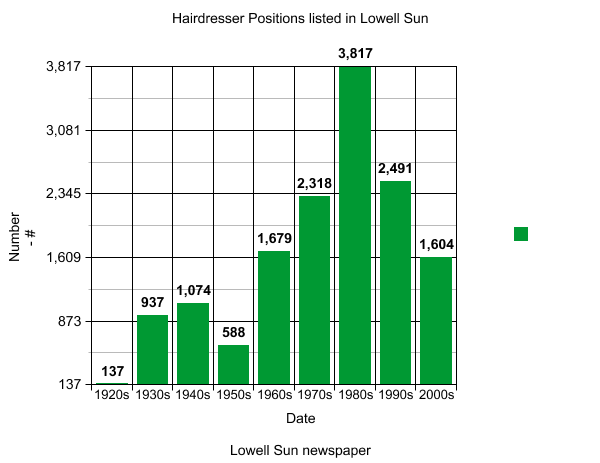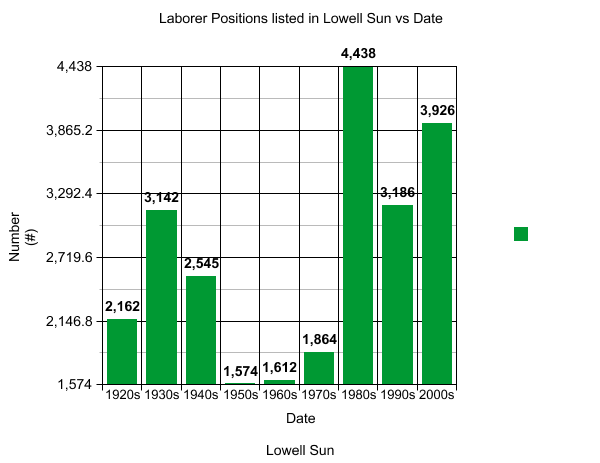Lowell Sun classifieds
Finding work within the city or in the environs like Tewksbury, Concord, Dracut, Chelmsford, Billerica, Bedford, etc. always remained an essential first challenge for anyone wishing to become an active member of the city’s tax rolls while aspiring to earn a decent salary for one’s efforts. The best and preferred approach to finding work focused on “word of mouth” information obtained from friends and relatives, who were already employed in the various companies operating within the city.
Back in the 1940s and 1950s, I, personally, heard of several openings through the good graces of such connections. As an example, this was my entryway to the wonderful world of the Air Force Cambridge Research Center in Bedford, Massachusetts, where scientific atmospheric research was the goal of the projects. The International Geophysical Year (1957 – 1958) was upon us so learning about weather balloons, albedo, temperature measurements and wind speeds was suddenly important to our world and to me since my days working with a small group of atmospheric researchers introduced me to the rigors of scientific methodology and record keeping.
However, most workers earning a living in the factories and stores within the city often had been hired after searching the “Help Wanted” ads in the local newspaper.
Announcements of job openings regularly appeared in “The Lowell Sun” to hekp any job-seeker find work. Listed below, are several summary graphs regarding key job categories such as: welder, hair dresser, nurse, fireman, waitress, etc. over the decades from 1920s to the 2000s. Had such information been available through the public library, for instance, then anyone wishing to enter the job market would have been afforded statistical data on which career direction to follow. More on this concept, later.
Butcher, Baker or Candle-Stick Maker?
In the early Twentieth Center in Lowell, most immigrants of all ethnic groups were offered employment in the most active industry of all, the textile mills. If these new arrivals had no experience in large-scale, industrial manufacturing, their labor category was classified as that of an “operative”, which usually designated that person as unskilled in the business of textile production. The local leather industry may have also used this label.
Given below is the bar-graph graphically representing the need for operatives in the local economy over the period from 1920 to 2000. Someone entering the job market in early 1940, for instance, could see that the call for operatives had increased from 4,482 in the 1920s to 6,562 in the 1930s. Naturally, he/she could not perceive that the market would peak to 8,027 in the 1940s, but the general trend over the previous 20 years might seem as encouraging, at least.
The textile mills provided for many indigent, desperate immigrant a meager lifestyle to keep body and soul together with the children working long hours in dangerous environmentsIn the case of my own mother and father (births in 1909 and 1911, respectively), these data might not have seemed particularly interesting, although the employment-related despair that my father experienced as a working mill-rat in the early 1950s might have precipitated his death at 43 in January 1953.
In contrast, my Mom chose to open her own beauty parlor in downtown Lowell around 1937 with – I believe – the financial assistance of her father, Paul Charbonneau, the home-delivery dairyman and entrepreneur.

Both my mother and my aunt Irene, the wife of my uncle Walter, had become interested in hair styling, permanents, shampoos, waves, etc., as a profession during the harsh days of the Depression. Although they did not have access to the information shown as a bar-graph, above.
It is worth noting that the call for hair-dressers in the 1950s dropped down to 588 or about half the number of listings found during the Depression years of the 1930s. It was during the 1950s that my mother most profited from her skills as a hair stylist.
Note that this graph clearly shows the golden years of the hairdressing business happened in the 1970 to the 1990 time period, which coincides with the economic recovery years of the city.
The tradesmen versus the laborer
Even as a young teenager, it was obvious to me that a man with a trade such as welder, bricklayer, plumber, architect or machinist had a much better chance to earn a decent wage with steady work than someone like a laborer on a construction site, who earns a living by pure brawn and the sweat of his brow. The tradesman and the laborer each contributes to society through a daylong effort at doing a good job, but the trades person can earn much more per day than the laborer. Such is the world we live in.
The graphical comparisons shown below between the call for a laborer versus that for various tradesmen in the period from 1920 to the year 2000 highlight the relative importance of each candidate in finding employment.
First of all, the laborer category is ill-defined, but it was, to my understanding,

used when I was a pre-teenager and later to mean a person, usually a man, with no characteristic set of skills. This was a man with no trade, but someone willing to do almost any job. There remained an important call for laborers during the Depression years and World War II. The availability of cheap labor, part-time and full-time in each case, must have kept the grinding wheels of the local industry at a pleasant hum.
The lot of the laborer became dismally poor in the 1950s and 1960s, but in the 1980s, this type of work reached a bonanza level. However, these data do not show the financial rewards that a laborer might expect for his/her efforts. Without some union support, which was available through an employment agreement with Raytheon, for instance, this person might never achieve a comfortable living standard.
Other job categories are considered below.
Bricklayer, Plumber and Electrician
During all of the Twentieth Century except for the years of the Great Depression, Lowell had spurts of financial renewal requiring the labor of specialists such as bricklayers, plumbers and electricians.
Bricklayer story here
Indoor toilets and lavatories became standard features in new houses and tenement blocks, multi-family apartment buildings, in the 1910s. Land developers proudly advertised these properties as having such new features as indoor plumbing plus electric lights to brighten up a living space with incandescent illumination. In addition, these new homes as provided private bathrooms.
People were urged to get rid of their large, enamel-coated metallic bathtubs, which were often placed in the center of the kitchen when someone needed a bath. Where and when did a sense of privacy come into play?
